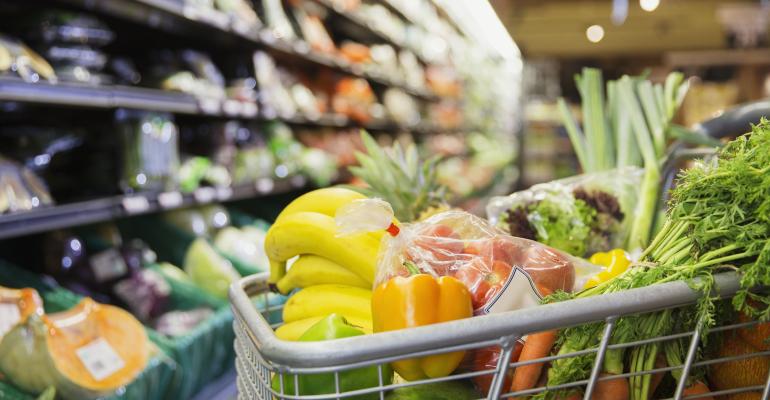 Scott Moses is a partner and head of grocery, pharmacy, and restaurants investment banking at Solomon Partners, an M&A investment banking advisory firm. He writes a quarterly column for Supermarket News about sector trends, including operating, valuation, and strategic dynamics.
Scott Moses is a partner and head of grocery, pharmacy, and restaurants investment banking at Solomon Partners, an M&A investment banking advisory firm. He writes a quarterly column for Supermarket News about sector trends, including operating, valuation, and strategic dynamics.
The following material was originally presented at the Groceryshop industry show last week.
I’m here to share 12 things you might not know about our industry.
First, quick background on me. I’ve been an M&A advisor for well over 20 years; I lead Solomon’s Grocery Advisory Practice and sit on the firm’s operating committee.
We’ve advised clients on dozens of grocery transactions all around the country. Full disclosure – I’m also part of the team advising Albertsons on the pending merger.
Now, for many years, I’ve been sounding the alarm about the rise of national/discount grocers – Walmart, Target, Costco, Amazon, Aldi, Dollar General, and Family Dollar/Dollar Tree – and the existential threat they pose to supermarket grocers, just as we’ve all seen with department stores, which have been marginalized over the past 20 years by some of the same forces.
I wrote an article nearly two years ago called “A Grocery Christmas Carol – The Ghost of Supermarkets Future.” I am nothing if not consistent.
Let’s start with something I hope everyone here does know: Grocery does NOT equal supermarkets, alone. Grocery equals:
- Supercenters
- Club grocers
- Discount, dollar, and drug grocers
- Specialty / ethnic
- Online grocers
- And yes, supermarket grocers.
They’re all grocers.
Lots of people who have been talking about our industry recently don’t seem to get this simple fact.
Let’s go through some more facts.
1. The First Thing You Might Not Know is what our industry looked like 20 years ago:
Ten of the top 15 American grocers used to be supermarkets. Walmart was No. 1, but Kroger was only $24 billion behind at that time. I know, you’re thinking, “only?” Hold that thought…
Costco and Target weren’t super focused on grocery yet. Winn-Dixie and A&P were still top grocers.
Look who’s not on the list at that time: Amazon barely sold groceries; they were 14 years from buying Whole Foods. Dollar General, Family Dollar, Aldi, and Trader Joe’s were much smaller. Online grocery was still developing.
2. You Might Not Know three clear factors that transformed grocery in the past 20 years:
First, national/discount grocers added 38,000 stores, doubling their store base and undermining the less than 26,000 supermarkets left: There’s now more consumer choice than ever. Second, consumers regularly shop at four grocery types and five banners. Third, online grocery has now quadrupled, led by Walmart, Target, Costco, and Amazon.
3. You Might Not Know that today, only five of the top 15 American grocers are supermarket grocers; the other 10 are national/discount grocers. There’s Amazon – about to be No. 4. Aldi’s heading toward No. 10 with its Winn-Dixie acquisition. In sum, the national/discount grocers, all non-union, have over 60% grocery share and there are still no national supermarket grocers.
Here are some other 20-year changes in terms of grocery share. Walmart’s up 12%; Amazon’s up 5%; Costco’s up 4%; Target, Dollar General and Aldi each up 2%. Conversely, Kroger’s down 1%; Ahold Delhaize is down 2% – mind you, this is after combining; Albertsons is down 7%.
Non-union grocers – in amber – their share is up over 30%.
Twenty years ago, supermarket grocers were the “primary shop” for 79% of Americans; that number is now down to 38%. Union share of grocery jobs has fallen from 50% to 15%, among the top 15 grocers.
So, how’d we get here?
4. Walmart, America’s No. 1 Grocer, by a wide margin.
Walmart’s been dominating the industry for so long it’s almost trite to mention them. You may know that over 90% of Americans live within 10 miles of a Walmart, and most of their sales are groceries.
You Might Not Know that Walmart has a $300 billion U.S. grocery business that has quadrupled in the past 20 years. It’s three times that of Kroger (that’s $200 billion more), as well as three times that of Costco, and five times that of Albertsons and Amazon.
5. Costco. You may know Costco is the No. 3 grocer in the U.S., with over $90 billion in grocery sales. Same groceries as supermarkets, just larger packs.
You Might Not Know that Costco’s U.S. grocery sales have tripled in the past 20 years. The average U.S. Costco does over $155 million per year in grocery sales, or $3 million per week; that’s three times that of an exceptional supermarket and over five times the average.
Then there’s valuation. At $240 billion, Costco’s worth 40% more than all public supermarkets and suppliers in the U.S., combined. The market clearly thinks they’re a good grocer.
6. Dollar grocers are undeniably grocers; same groceries as supermarkets, just smaller packs.
You Might Not Know that Dollar General has over 19,000 stores and is planning to get to 34,000.
Look at how much they’ve grown. Over a third of all U.S. stores that opened in 2021 and 2022 were dollar stores; Dollar General alone opened 2,060 grocery stores in those two years.
You may have seen a recent WSJ article — “One-Percenters Keep Shopping at the Dollar Store.”
Couple of quotes really resonate:
“No matter how much you make, there is no longer a stigma in going after a good deal.”
“A carrot is a carrot is a carrot.”
As a result of this dynamic, Dollar General and Dollar Tree/Family Dollar together have a $50 billion grocery business, in over 35,000 stores.
7. Aldi. You Might Not Know that Aldi is the world’s No. 3 grocer; No. 2 in Europe.
The Albrecht family in Germany who owns Aldi also own Trader Joe’s. They’re the 11th wealthiest family in the world. Even in England, Aldi and Lidl have roughly 16% grocery share; that’s also their plan for the U.S. And Aldi’s growing fast here – 680 grocery stores 20 years ago to 2,800, including the 400 Winn-Dixies they’re buying; 2,800 stores is more than Kroger. Sales are up from $3 billion to $27 billion, with a lot of non-union jobs. That’s what a huge global grocery business can do.
8. We all know online grocery has grown a lot since the COVID-19 pandemic.
You Might Not Know the largest online grocers are not supermarket grocers – they’re Walmart, Target, Costco, and Amazon, and they all have AA or A credit ratings. This is critical; that gives them nearly unlimited capacity to invest in price, wages, marketing, logistics, and technology, well more than any supermarket.
Here’s a clear manifestation: Walmart’s ubiquitous fulfillment footprint – over 200 FCs across the country. Walmart did 36% of all U.S. online grocery sales last quarter.
Here’s Amazon’s fulfillment footprint – over 400 FCs and over 1,000 hubs and sorting facilities.
9. You probably know Amazon is a trillion-dollar company.
You Might Not Know it’s worth three times Walmart, six times Costco, 34 times Ahold Delhaize, 37 times Kroger, and over 70 times Albertsons. Amazon’s actually worth more than all U.S. grocers combined. That’s Walmart, Target, Costco, BJ’s, Publix, Ahold, Kroger, Albertsons, Dollar General, Dollar Tree/Family Dollar, CVS, Walgreens, Sprouts, etc. All of them.
Now, Amazon’s clearly had the same epiphany as Walmart did 30 years ago:
If you want to be the world’s No. 1 retailer, you need to be the No. 1 grocer.
Andy Jassy has said it clearly in recent earnings calls:
“Grocery is a really important and strategic area...People don’t realize we have a pretty significant-sized grocery business...that is continuing to accelerate.”
And then:
“We believe we have the opportunity for it to be much larger for Amazon….”
But by Jassy’s own admission, Amazon hasn’t figured out grocery yet. So, given their financial capacity and clear commitment to grocery leadership, it begs one simple question: “What happens when they do?”
Here’s one estimate. In the next 10 years, Amazon could end up capturing $334 billion in U.S. grocery sales, or over 16% share.
10. Instacart. Big IPO recently, and fascinating S-1.
You Might Not Know they reach 95% of North American households, through 1,400 retail banners and 80,000 stores – serving millions of families. Brings a truly unprecedented degree of grocery choice across the country.
11. We all know the national grocers have grown a lot over the last 20 years:
You Might Not Know Walmart’s U.S. grocery business has grown by $240 billion; Costco’s up over $70 billion; Amazon/Whole Foods is up $60 billion and is about to overtake Albertsons as the No. 4 U.S. grocer; Target/Shipt is up $40 billion; dollar grocers are up over $40 billion.
When you add it all up, the national/discount grocers are up over $500 billion in grocery sales and over 38,000 in new grocery stores, 96 times more growth than supermarket grocers.
12. You Might Not Know the financial consequences of all this on supermarket grocers.
EBITDA margins were 75% higher 20 years ago than before COVID, but everyone’s had to lower prices and gross margin to compete with the fast-growing national grocers. Kroger’s gross margin is actually lower than any of Amazon, Walmart, Target, Dollar General, Dollar Tree/Family Dollar, or any other public supermarket, by a wide margin.
Why? Well, 20 years ago Kroger saw the growth by Walmart, Target, Costco, and other national / discount grocers, and launched Customer 1st; since then, they’ve consistently invested in better prices, both generally and at acquired stores like Harris Teeter and Roundy’s.
Kroger’s gross has come down by over 5% in the past 20 years, while Amazon, Ahold, Walmart. and Dollar General have all increased.
As a result, there’s a vast EBITDA difference between Amazon, Walmart, and Costco vs. everyone else. This is critical – it’s not all about sales. Sears and Kmart had lots of sales, until they didn’t. EBITDA and valuation drive liquidity; they drive capacity to acquire and retain customers – that’s how you compete in retail.
Kroger’s EBITDA is ranked No. 6 among U.S. grocers; Albertsons, No. 10.
Valuation’s the same story. Kroger’s No. 8; Albertsons, No. 12.
Remember, grocery is a global business. Kroger and Albertsons are just the 9th- and 10th-largest U.S. grocers by global store count.
So, I’m going to finish where I started.
Some people out there talking about grocery either don’t know grocery facts or are just ignoring them.
Now, folks are entitled to their opinion; but for capitalism to work – indeed for democracy to work – you can’t have your own facts. When you do the math, and add up these grocery facts, the implications are clear. Supermarket grocers are under siege. For years, I’ve been speaking about transactions that supermarket grocers need to avoid replicating department stores and being disintermediated by national/discount operators.
I’ll say just one thing about the merger: Kroger/Albertsons is NOT Albertsons/Safeway:
Kroger’s better price and union jobs track record is undeniable. C&S is a great, pro-union divestiture buyer, just as they were when we merged Price Chopper/Tops – 100 years of grocery operating heritage; well capitalized to invest and compete.
But most important, Kroger’s made some clear commitments: no store closures; no front-line job losses. Period, full stop. More price investment; $1 billion for better wages; donating 10 billion meals to combat food insecurity.
Look, I’ve known Rodney McMullen for nearly 20 years; I’ve known Vivek Sankaran for years as well. These are honorable people. To me, their word counts. I thank you for reading.





